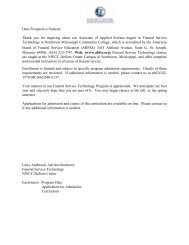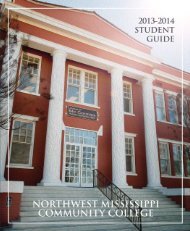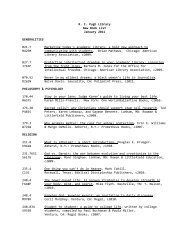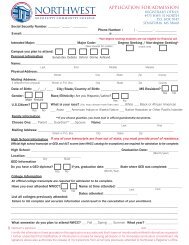Coping with Seven Disruptive Personality Types in the Classroom
Coping with Seven Disruptive Personality Types in the Classroom
Coping with Seven Disruptive Personality Types in the Classroom
You also want an ePaper? Increase the reach of your titles
YUMPU automatically turns print PDFs into web optimized ePapers that Google loves.
ConclusionFaculty members can expect to deal <strong>with</strong> <strong>in</strong>creas<strong>in</strong>g numbers of difficult students aseducational access widens and students who might not have attended college <strong>in</strong> decadespast now f<strong>in</strong>d <strong>the</strong>ir way to campus. This means that <strong>in</strong>structors will need to be better<strong>in</strong>formed and prepared to respond to a wider array of challenges than <strong>the</strong>y might have beenexpected to deal <strong>with</strong> previously.Clearly, <strong>the</strong> most important priorities <strong>in</strong> deal<strong>in</strong>g <strong>with</strong> disruptive students have to bema<strong>in</strong>ta<strong>in</strong><strong>in</strong>g safety and protect<strong>in</strong>g <strong>the</strong> campus community from threats posed by potentiallydangerous, troubled students. These priorities require recognition of <strong>the</strong> warn<strong>in</strong>g signs oftrouble and preparedness to respond appropriately and decisively.O<strong>the</strong>r priorities <strong>in</strong>clude ma<strong>in</strong>ta<strong>in</strong><strong>in</strong>g a classroom atmosphere of respect and civility,avoid<strong>in</strong>g be<strong>in</strong>g manipulated by students <strong>with</strong> unreasonable demands, respond<strong>in</strong>gappropriately to unfounded allegations, and protect<strong>in</strong>g oneself and one’s <strong>in</strong>stitution fromfrivolous lawsuits.By follow<strong>in</strong>g due process, consult<strong>in</strong>g <strong>with</strong> adm<strong>in</strong>istrators, and deliver<strong>in</strong>g early warn<strong>in</strong>gs as<strong>in</strong>dicated, <strong>in</strong>structors can guard aga<strong>in</strong>st many of <strong>the</strong> hazards of deal<strong>in</strong>g <strong>with</strong> <strong>the</strong> moredifficult students <strong>in</strong> <strong>the</strong> classroom.Understand<strong>in</strong>g how <strong>the</strong> range of student misbehavior tends to cluster along certa<strong>in</strong>dist<strong>in</strong>ctive, recognizable styles is empower<strong>in</strong>g and helpful to <strong>in</strong>structors. “Unusual”behaviors no longer seem random and unpredictable; <strong>in</strong>stead, <strong>the</strong>y are manifestations ofknown personality styles that exist not just <strong>in</strong> <strong>the</strong> college classroom but <strong>in</strong> <strong>the</strong> wider societyas well. As such, <strong>the</strong>y become more manageable, familiar, and controllable.Many <strong>in</strong>structors report additional concerns or questions beyond <strong>the</strong> seven disruptivepersonality types already identified; <strong>the</strong>se are addressed <strong>in</strong> <strong>the</strong> follow<strong>in</strong>g section, “AdditionalIssues and Concerns.” This last section of this white paper deals <strong>with</strong> extenuat<strong>in</strong>gcircumstances, nonverbal behaviors, and, perhaps most important, “red flags” that portendphysical risk when deal<strong>in</strong>g <strong>with</strong> dangerous, threaten<strong>in</strong>g students.34


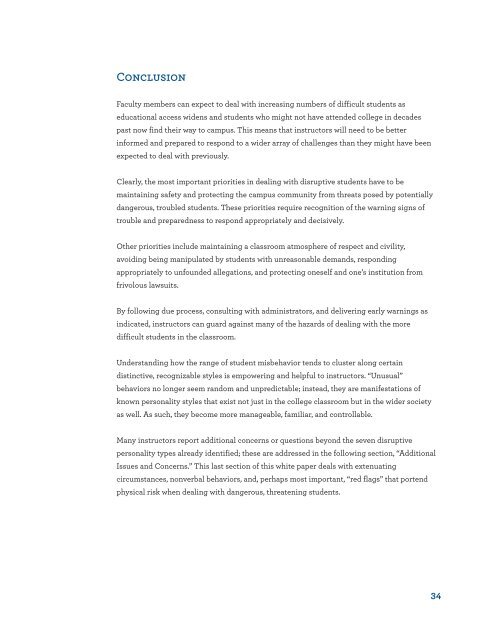
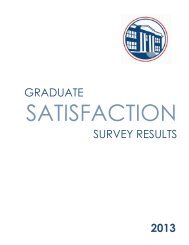
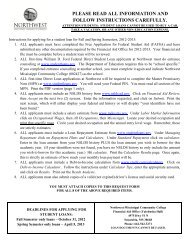




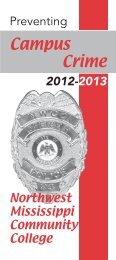

![Pro-Dental Hygiene [Major Code T34] - Northwest Mississippi ...](https://img.yumpu.com/35524032/1/190x149/pro-dental-hygiene-major-code-t34-northwest-mississippi-.jpg?quality=85)
